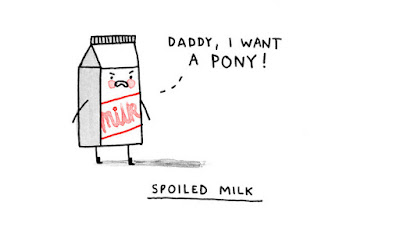Milk Spoilage
Spoilage makes the milk unwholesome. It occurs in different ways and in a variety of shapes. Microorganisms cause deterioration of milk and these may come from the environment or may come from the person (s) involved in the milking process.
Risks of drinking spoiled milk
It can cause food poisoning that may result in uncomfortable digestive symptoms, such as stomach pain, nausea, vomiting, and diarrhea. You don't need to worry if you accidentally ingest a small sip of spoiled milk, but avoid drinking it in large — or even moderate — quantities.
Spoilage may be prevented in the raw milk as it contains:
- Lactoperoxidase
- Agglutinins
- Lyzozymes
These are also called inhibitory substances of spoilage.
 |
| Milk spoilage |
Types of Spoilage
There are six different types of spoilage as follows:
- Gas production
- Proteolysis
- Sliminess / Ropiness
- Changes in milk fat
- Changes in milk flavor
- Changes in milk color
Gas production:
Milk contains lactose which produces acids (such as propionic, lactic, and butyric) and CO2 on fermentation. When this fermentation occurs at faster rate, then raw milk present a foamy layer on the upper surface. If it continues then air bubbles becomes entrapped and gas becomes saturated throughout the body of the milk. It is also termed as “Stormy Fermentation”. Such milk is not fit for human consumption. Gas production may be due to gas producing bacteria such as: Colliforms, clostridium and bacillus species.
Proteolysis:
It is the destruction of milk proteins especially of casein. There are different types of proteolysis:
Acid Proteolysis:
Milk whey separated and pH >5.2. Milk taste will be soured.
Alkaline Proteolysis:
Milk whey separated and pH >6.9 (towards neutral and alkaline). Milk taste will be bitter.
Sweet curdling:
It is due to bacterial contamination i.e. bacillus cerus – it release enzymes “protease” which targets the casein. Bacteria use lactose and convert into acids and aldehyde components. Milk is sweet in taste.
Slow Proteolysis:
If raw milk is heated to certain pasteurized temperature or boiling temperature, it will cause destruction of bacteria which results into release of endogenous proteases in the milk. These proteases cause slow proteolysis of the milk.
Proteolysis due to Anaerobic Bacteria:
Bacillus and clostridial species are heat resistant. Their presence is not eliminated easily at any stage. That’s why result into specific kind of smell names as butyrine smell. Clostridium species are mostly involved in the alkaline proteolysis of milk.
Roppiness or Sliminess:
In case of roppiness or sliminess milk viscosity is increased. If you touch the surface of milk, a cord/rope like structure is formed. Roppiness or sliminess may be bacterial or non-bacterial in origin:
Non-bacterial:
It may be due to normal thickness of cream itself. Such milk is not regarded as spoiled milk.
It may be due thin film of casein and lactalbumin. These when mix together at refrigeration temperature, sliminess may be seen in the bottom part of the milk
If there is non-infectious mastitis to the animal, then leukocytes and fibrin contents enhanced. These two make the milk thicker and produce roppiness or sliminess in the milk.
Bacterial:
Conditions are irreversible. Certain microorganisms have properties to produce sliminess at the top and other produce throughout the body of the milk. Mostly capsulated bacteria produce sliminess.
Changes in Milk Fat:
There are three particular conditions which cause changes in the milk fat.
Oxidation of Unsaturated Fatty Acids:
Upon oxidation, milk fat yields a lot of aldehydes, ketones and variety of acids. Oxidation imparts tellowy odour.
Hydrolysis of Overall Milk Fat:
Hydrolysis occurs due to the acidity of enzyme “lipase” which separates the molecules of glycerols from fatty acids and results into release of free fatty acids in the milk which brought obnoxious change in the milk. Hydrolysis gives rise to putrefied odour (rotten egg like smell).
Combined Condition of Above:
Change in milk fat may be due to certain bacteria which gives a combination of both odours discussed before:
Change in the Color of Milk:
Normal color of milk is light or off-white (cow) and shining white (buffalo). Variety of bacteria responsible for bringing change in the color of the milk:
Blue color -------------------------- Pseudomonas synciani
Red color --------------------------- Brubibacterium erythrogenes, Sarcinia marcense
Yellow color ----------------------- Pseudomonas synxantha
Brown color ------------------------ Pseudomonas putrificians
Green color ------------------------- Pseudomonas aurogenosa
These above are all bacteria except brubibacterium which is yeast. Milk with any abnormal discoloration must be declared as unwholesome and spoiled.
Change in the Flavor of Milk:
The change in the flavour of the milk is discussed as follows:
Sour Flavour:
It is due to acidic changes in the milk. Sourness in the milk is described in 3 different forms:
Clean: Low contents of acids due to environment of Streptococcus lactis. There will be sour acidic flavour.
Aromatic: It is due to bacteria which are responsible for moderated type of acidic components.
Sharp: It is due to the environment of clostridial species; high acidic contents.
Bitter Flavour:
It is due to alkaline changes in the milk.
Potato-like Flavour:
Pseudomonas mucidolense (a bacterium) produces potato like flavour in the milk.
Fishiness:
A typical flavour of fishiness is produced by Acromian hydrophila. It is due to formation of tri-methyl amine. Trimethyl amine gives fishiness flavour to the milk.
